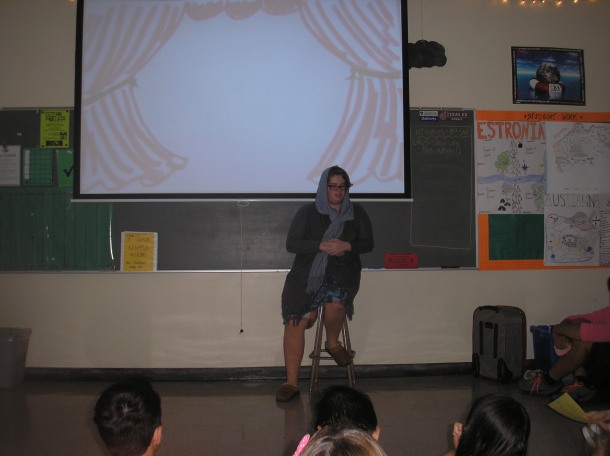This Thanksgiving I’m thankful for tradition.
Joan was a great interviewer. She grew up to be, after all, an oral historian. Even when she wasn’t working professionally, she managed to get information out of everyone. My brothers and I joked she worked for the MBI: The Morrison Bureau of Investigation. I think she was so easy to talk to and open up to because she was genuinely interested in people’s perspectives. She didn’t want to impose her view of the world on others, but wanted to get the conception of life other people had.
Her work as an interviewer began early. At Lakeview High, she was a reporter for the school newspaper, the Midway.
Friday, November 4, 1938
Hello! Well—guess what? We studied bread mold today—just before lunch too. It’s all gushy and green and full of spores and reproduction and all (biology is so indelicate).
Then I’m supposed to ask the leading boys of the school what their ideal girl is in life for “Vox Pop” next week. You know, I run the “Inquiring Reporter” column in the Midway—every week—four weeks so far. Some of the columns are pretty cute. This week was the “ideal girl.” In connection with my column, I asked Orville (him with the mustache) if he was a leading boy—he looked so embarrassed and modest and all, but he’s on the track team.
Then at U-High she continued her reporter work:
Sunday, February 5, 1939
. . . Church this morning. Did I tell you I’ve been wearing my hair page boy?
Today I didn’t however—wore it pretty and fluffed over my face, and with my green knitted hat I looked sorta cute.
Of course I wear rouge nowadays and a horrid but glamorous orangey lipstick that matches the yarn flowers on my brown sweater.
Took communion today but my conscience bothered me—I’m not sure what I think nowadays and there’s no use being hypocritical. (Anyhow, I was hungry).
. . . Friday I had a horrid Iliad test. A “well-greaved man” is one with good leg armor as I discovered (and rightly!) by the process of elimination. They hadn’t invented chain mail then, had they?
Jim Alter had been ribbing Barbara, the other third page editor, for using both “Aunt Polly” and “Inquiring Reporter” on the page for her week (space fillers). So I just laughed and laughed on Friday because, next week being his page:
He: “Oh Joan—wait a minute!” Comes up to me and begins to walk up hall with me, muttering incoherently.
Me (brightly): “Yes?”
He: “Gurgle, gurgle.” We finally reached girls’ locker room and I waited for him to speak. Finally: “Could you have both ‘Aunt Polly’ and ‘Inquiring Reporter’ columns next week?”
Me: “Oh—oh, yes, of course—” (smirk, smirk).
He (dashing away): “Gurgle!”[1]
[1] The 1940 yearbook, The Correlator, comments, “Feature editor Joan Wehlen suffered most, for there was seldom enough space for her excellent material.”
Once she was a grown woman with three children, she became an oral historian, eventually publishing two books and teaching at the New School in New York City. One of the trailblazers in the field who inspired her was Studs Terkel.
From Chicago like Joan, Studs Terkel had a radio show and wrote numerous oral histories, most notably The Good War and Hard Times.
Last year my son, John, in his 8th grade Social Studies class had a Studs Terkel project. They had to choose from a list of Terkel’s interviewees, edit the transcript, and perform a 60 second version of the interview. What a super project! Characters ranged from Frank Wills, “An honest guard who uncovered the Watergate Scandal,”
to Dolores Dante, “A waitress who worked in the same restaurant for 23 years.”
There was some cross-dressing going on: girls played males, boys played females. All the kids did a great job.
John was moved by the story of Florence Reese, “A tough 79-year-old Southern grandma who lives in her past.” John did a super job with costume and accent portraying this amazing and groundbreaking trailblazer in civil rights for miners.
As John writes in his analysis of Mrs. Reece, “Well the first obvious thing I noticed was that she was old. She grew up in a very poor town with very little education evident by not the best grammar and her flat out saying that there was no high school. In most mining towns the distribution of wealth is extreme with the workers, which makes up most of the town, earning very little and the mine owners earning a lot and since she was a miner’s daughter she was on the lesser end of the distribution. She was poor. She is clearly very liberal. Most of the story is about unionizing the workers of America which is a liberal stance on things and that you shouldn’t drown the poor first just because they are poor.”
This is John’s “Costume plan: I will wear my mother’s blue dress and grey/red shawl a scarf around my head to cover up my hair and to make me look like a babushka, even though I am from Tennessee, it makes me look older. I will also wear my mother’s slippers.”
I’m so glad the tradition continues of oral history in our family. Maybe John will want to interview you someday!































